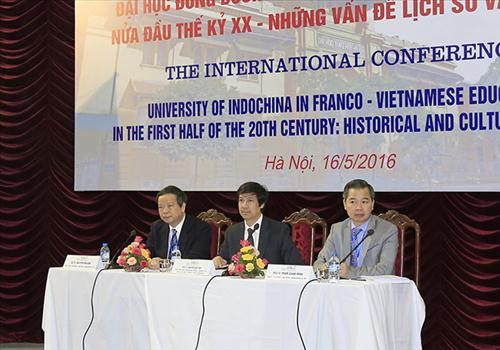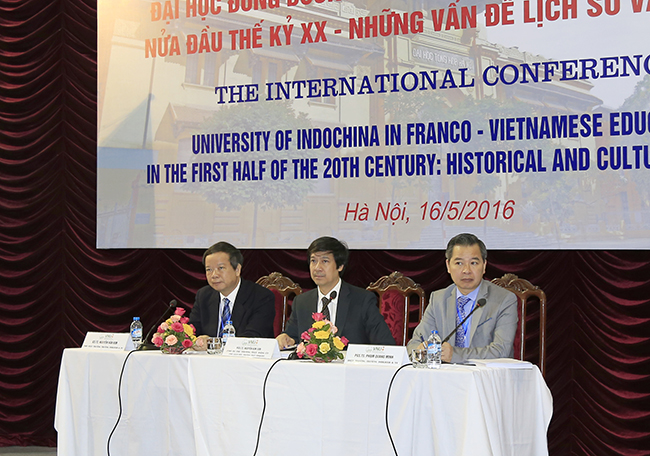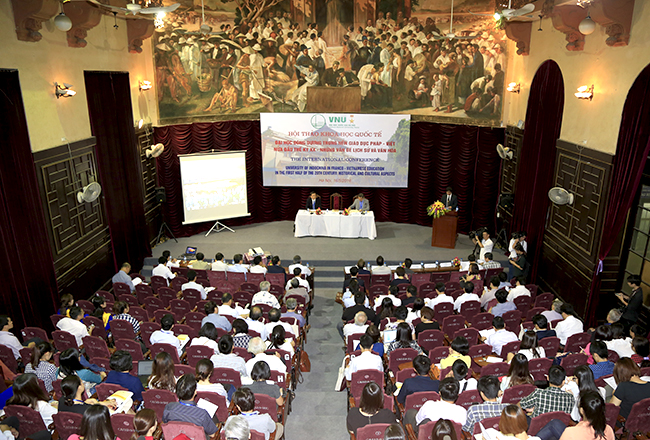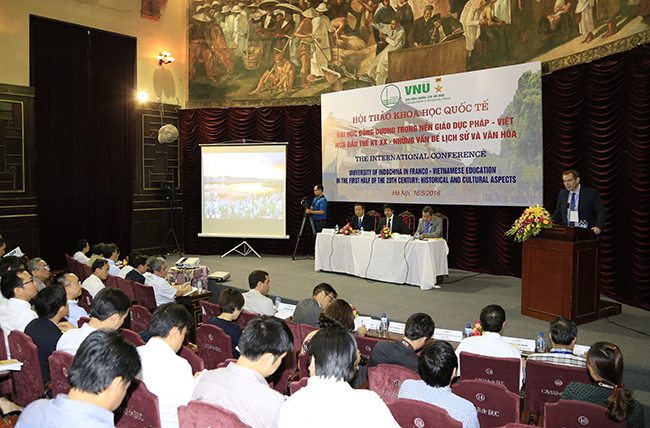

From left to right: Prof. Dr. Nguyen Van Kim - Vice Rector of the University of Social Sciences and Humanities, Assoc. Prof. Dr. Nguyen Kim Son - Vice Rector of VNU, Assoc. Prof. Dr. Pham Quang Minh - Rector of the University of Social Sciences and Humanities/Photo: Quoc Toan
On May 16, 1906, Governor-General Paul Beau signed Decree No. 1514a establishing the University of Indochina. This was an important legal document marking the birth of the first university following the modern model of higher education in Vietnam.
Immediately after the success of the August Revolution, President Ho Chi Minh signed Decree No. 45/SL to establish the Faculty of Letters within the University, with Mr. Dang Thai Mai as Director. The "University" mentioned here is the Indochina University, because before that there was no other educational institution with the name "University" in Vietnam.
On November 15, 1945, the University held the opening ceremony of the first academic year and was officially named the Vietnam National University. In the initial stage, the University had 5 faculties: Medicine, Science, Literature, Social Politics and Fine Arts. Participating in teaching in all faculties were Vietnamese professors, cultural figures, political and social activists, including President Ho Chi Minh and comrades Pham Van Dong and Vo Nguyen Giap. President Ho Chi Minh attended, spoke at the opening ceremony and awarded degrees to students of the previous course whose studies had been interrupted.

Photo: Quoc Toan
On June 5, 1956, the Prime Minister signed Decision No. 2183/PC to establish 5 universities and 15 vocational high schools, including Hanoi University of Science. Accordingly, Hanoi University of Science is the direct successor of Vietnam National University. In addition to facilities, organizational structure and academic tradition, Hanoi University of Science also inherits the first team of teachers and scientists trained and matured from Indochina University and Vietnam National University.
In 1993, the Government decided to establish VNU to create positive and breakthrough changes, meeting the needs of the country's development in the new situation. VNU was built on the core of Hanoi University of Science. This is an affirmation of the modern multi-disciplinary and multi-field university model on the basis of continuing the academic tradition initiated by the University of Indochina and promoting that tradition to a new level.
On June 5, 1956, the Prime Minister signed Decision No. 2183/PC to establish 5 universities and 15 vocational high schools, including Hanoi University of Science. Accordingly, Hanoi University of Science is the direct successor of Vietnam National University. In addition to facilities, organizational structure and academic tradition, Hanoi University of Science also inherits the first team of teachers and scientists trained and matured from Indochina University and Vietnam National University.

Associate Professor Dr. Nguyen Kim Son - Vice President of VNU speaking at the Conference/Photo: Quoc Toan
In 1993, the Government decided to establish VNU to create positive and breakthrough changes, meeting the needs of the country's development in the new situation. VNU was built on the core of Hanoi University of Science. This is an affirmation of the modern multi-disciplinary and multi-field university model on the basis of continuing the academic tradition initiated by the University of Indochina and promoting that tradition to a new level.
In his opening speech at the conference, Associate Professor Dr. Nguyen Kim Son - Vice President of VNU affirmed: VNU has inherited and continued a long-standing university tradition from Indochina University regarding the reputation of its team of influential teachers and scientists. That continuity and inheritance is also reflected in the multi-disciplinary, multi-field university model.,be raised to a new level; in the orientation of an international university, integrating with the world. With that meaning, this scientific conference is an opportunity to clarify the historical issues of a special development period of the country's higher education, the shaping period of modern higher education. Scientists will together clarify the historical issues of the establishment of the Indochina University, in order to draw historical lessons for today's issues. In particular, those historical experiences help affirm and orient the development of the Vietnam National University, Hanoi at present and in the future.

The French Ambassador Extraordinary and Plenipotentiary to Vietnam speaks at the Conference/Photo: Quoc Toan
At the Conference, Mr. Jean-Noël Poirier - Ambassador Extraordinary and Plenipotentiary of France to Vietnam - said: The history of Indochina University has been very successful because the school has trained many generations of talented intellectuals, engineers, and researchers, accompanying the development of Vietnam. The success of Indochina University is demonstrated through the success of other universities such as Hanoi Medical University, Vietnam School of the Far East. Currently, it can be seen that Hanoi National University and universities located in major cities of Vietnam all follow the spirit of Indochina University.
He also expressed his joy at seeing that “although the colonial period was not a bed of roses, the French were surprised when talking to the Vietnamese, because most of them mentioned beautiful memories such as French colonial architecture as well as universities with French contributions”. And 110 years after the establishment of the Indochina University, the cooperation in the university field between Vietnam and France is the glue that binds the bilateral relations between the two countries in the coming time.
The conference had 16 presentations, focusing on two main contents: Indochina University - Issues on higher education; Indochina University and the development of education and training of human resources in Vietnam.
Author:Thanh Ha
Newer news
Older news